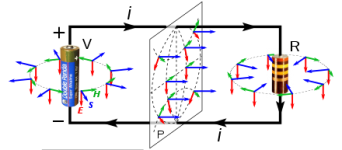- Location
- Chapel Hill, NC
- Occupation
- Retired Electrical Contractor
I saw this on another forum and thought the theory minded members would get a kick from this. Personally it is a bit over my head...
Excellent article, Sir Dennis!I saw this on another forum and thought the theory minded members would get a kick from this. Personally it is a bit over my head...
Isn't that just an air-core transformer?Would that theory explain ability for wireless charging through induction.
The fraction to which you refer is called the "velocity factor" -- the actual propagation speed in a cable, referenced to the speed of light in free space -- and is rarely specified for anything but RF cables.... I would think the fields still need to propagate along the length of the wire at some fraction of the speed of light ...
But does the premise that the fields "jump the gap" between the battery and the bulb to light up the bulb, as proposed in the video, make sense? I understand the electric and magnetic fields of the battery and wires immediately surrounding the battery would extend across the 1 meter gap, but is that really what is lighting the bulb initially? I have a hard time picturing the Poynting vector in this case. The delay should be t = x / (c * VOP), with x being the length of the wire, not the spatial distance between the battery and bulb.The fraction to which you refer is called the "velocity factor" -- the actual propagation speed in a cable, referenced to the speed of light in free space -- and is rarely specified for anything but RF cables.

Not a clue. I quit wasting my time on YouTube crackpot hypotheses proclaiming "The Big Misconception".But does the premise that the fields "jump the gap" between the battery and the bulb to light up the bulb, as proposed in the video, make sense? ...
Ah, yes, the lure of special knowledge. What they don't want you to know, what most people think is wrong, etc. I know people to whom a preface like that is all it takes to convince them that what follows is the truth. It makes them feel special.Not a clue. I quit wasting my time on YouTube crackpot hypotheses proclaiming "The Big Misconception".
When somebody says "All y'all got it wrong, despite a hundred years of analysis, experimentation & implementation", I turn the page. Maybe I might be interested if it said, "Here's an alternative perspective on the existing body of theory & data ... ".
When somebody says "All y'all got it wrong, despite a hundred years of analysis, experimentation & implementation", I turn the page. Maybe I might be interested if it said, "Here's an alternative perspective on the existing body of theory & data ... ".

